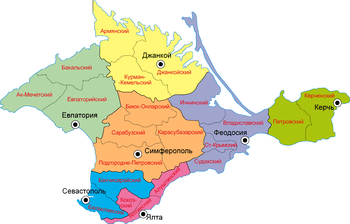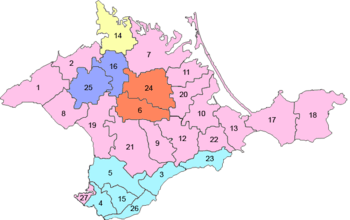Crimean Autonomous Soviet Socialist Republic
| Crimean ASSR Qrьm ASSR Крымская АССР | ||||||
| ASSR of the Russian SFSR (1921–1941), (1944–1945) ASSR of the Ukrainian SSR/Ukraine (1991–1992) | ||||||
| ||||||
| ||||||
 | ||||||
| Capital | Simferopol | |||||
| Government | Autonomous Soviet Socialist Republic | |||||
| History | ||||||
| • | Established | October 18, 1921 | ||||
| • | Became Crimean Oblast | June 30, 1945 | ||||
| • | Re-established | February 12, 1991 | ||||
| • | Disestablished | 6 May 1992 | ||||
| Today part of | ||||||
| Administrative divisions of the Ukrainian SSR |
|---|
| First level |
|
|
| Second level |
|
| Third level |
|
|
|
Crimean Autonomous Soviet Socialist Republic[lower-alpha 1] was an Autonomous Soviet Socialist Republic of the Russian SFSR located on the Crimean Peninsula.
History
It was created on October 18, 1921 as the Crimean Autonomous Socialist Soviet Republic of the Russian SFSR. It was renamed the Crimean Autonomous Soviet Socialist Republic on December 5, 1936 by the VIII Extraordinary Congress of Soviets of the USSR.[1]
Crimea was under de facto control of Nazi Germany from September 1942 to October 1943, administratively incorporated into Reichskommissariat Ukraine as Teilbezirk Taurien. Alfred Frauenfeld was appointed as General Commissar (although it seems that Frauenfeld spent most of his time in Crimea researching the peninsula's Gothic heritage and the actual government was in the hands of Erich von Manstein).[2]
In 1944, under the pretext[3] of alleged collaboration of the Crimean Tatars with the Nazi occupation regime, the Soviet government on orders of Joseph Stalin and Lavrentiy Beria deported the Crimean Tatar people from Crimea.[4]
Actual collaboration in the military sense had been rather limited, with a recorded 9,225 Crimean Tatars serving in anti-Soviet Tatar Legions and other German formed battalions,[5] but there was in fact a surprisingly high degree of co-operation between the occupation government and the local administration; this has been significantly due to Frauenfeld's unwillingness to implement the policy of brutality towards the local population pursued by Reichskommissar Erich Koch, which led to a series of public conflict between the two men.[6] The constitutional rights of the forcibly-resettled Tatars were restored with a decree dated September 5, 1967, but they were not allowed to return until the last days of the Soviet Union.[7]
The Crimean ASSR was converted into the Crimean Oblast of the RSFSR on June 30, 1945 by the decree of the both presidiums of the Supreme Soviet of USSR and the Supreme Soviet of RSFSR (published on May 26, 1946), and the Crimean Oblast was transferred to the Ukrainian SSR in 1954.[8]
The ASSR was re-established on February 12, 1991 by the Supreme Soviet of the Ukrainian SSR following a referendum held on January 20, 1991,[9] and it became the Autonomous Republic of Crimea, part of the newly independent state of Ukraine, effective May 6, 1992.
Administrative divisions

With the establishment of the autonomous republic in 1921, Crimea was divided into seven okrugs, which in turn were divided into 20 raions:
In November 1923, the okrugs were abolished and 15 raions were created instead, but in 1924, five of these were abolished.

On 30 October 1930, the remaining ten raions were reorganized into 16 new ones, and four cities under direct republican control. In 1935, 10 new raions were added and one abolished. In 1937, one more raion was established. Some of the raions had national status for Crimean Tatars, Jews, Germans and Ukrainians. By the beginning of World War II, all of these raions had lost their national status.
Heads of State
Russian SFSR
- Central Executive Committee
- November 7, 1921 – August 1924 Yuri Gaven (Janis Daumanis)
- August 1924 – January 28, 1928 Veli Ibraimov
- January 28, 1928 – February 20, 1931 Memet Kubayev
- February 20, 1931 – September 9, 1937 Ilyas Tarkhan (arrested on September 8, 1937)
- September 9, 1937 – July 21, 1938 Abdul-Celil Menbariyev
- Supreme Soviet
- July 21, 1938 – May 18, 1944 Abdul-Celil Menbariyev (deported to Middle Asia as part of Stalin's collective punishment for collaboration with the Nazis)
- May 18, 1944 – June 30, 1945 N.Sachiova (acting)
Ukrainian SSR/Ukraine
- March 22, 1991 – May 9, 1994 Mykola Bahrov
Heads of Government
Chairmen of Revkom
- November 16, 1920 – February 20, 1921 Bela Kun
- February 20, 1921 – November 7, 1921 Mikhail Poliakov (become the one of NKVD troika)
Council of People's Commissars
- November 11, 1921 – May 16, 1924 Sakhib-Garey Said-Galiyev
- May 16, 1924 – May 1924 I.Goncharov (acting)
- May 1924 – March 21, 1926 Osman Deren-Ayerly
- March 21, 1926 – May 1929 Emir Shugu
- May 1929 – September 16, 1937 Abduraim Samedinov (arrested September 17, 1937)
- 1937 – April 5, 1942 Memet Ibraimov
- April 5, 1942 – May 18, 1944 Ismail Seyfullayev (under de facto control of Nazi Germany during September 1, 1942 to October 23, 1943)
- May 18, 1944 – June 30, 1945 Aleksandr Kabanov
Council of Ministers
- March 22, 1991 – May 20, 1993 Vitaliy Kurashik
Principal Chekists
- Cheka
- until April 1921 Mikhail Vikhman (later in Chernihiv)
- April 1921 – June 1921 Smirnov
- June 20, 1921 – 1921 Fyodor Fomin (transferred to Kiev)
- November 11, 1921 – February 1922 Aleksandr Rotenberg
- Crimea GPU
- February 1922 – September 11, 1922 Aleksandr Rotenberg
- September 11, 1922 – April 25, 1923 Stanislav Redens
- Merged GPU
- April 25, 1923 – June 9, 1924 Stanislav Redens
- May 20, 1924 – July 29, 1925 Sergei Szwarz (transferred to the Special department of the Black Sea Navy)
- 1925 Aleksandr Toropkin (transferred to Ural)
- October 1926 – April 26, 1928 Ivan Apeter (transferred to the Special department of the Black Sea Navy)
- OGPU
- April 26, 1928 – December 1929 Grigoriy Rapoport (transferred to Belarus Military District)
- January 23, 1930 – July 10, 1934 Eduard Salins (Eduards Saliņš)
- Narkom of State Security
- February 26, 1941 – July 31, 1941 Major Grigoriy Karanadze
- October 5, 1943 – July 5, 1945 Commissar of the 3rd rank Pyotr Fokin
See also
Notes
- ↑ Modern Crimean Tatar: Qırım Muhtar Sotsialist Sovet Cumhuriyeti; Official Crimean Tatar name in the Uniform Turkic Alphabet: Qrьm Avonomjalь Sotsialist Sovet Respublikasь; Russian: Крымская Автономная Социалистическая Советская Республика Krymskaja Avtonomnaja Socialističeskaja Sovetskaja Respublika
References
- ↑ Handbook of history of Communist Party and Soviet Union
- ↑ Alan W. Fisher, The Crimean Tatars, 1978, p. 156
- ↑ line Encyclopedia of Mass Violence. "Sürgün: The Crimean Tatars' deportation and exile – Online Encyclopedia of Mass Violence". Massviolence.org. Retrieved 2014-02-27.
- ↑ Subtelny, Orest (2000). Ukraine: A History. University of Toronto Press. p. 483. ISBN 0-8020-8390-0.
- ↑ Document reproduced in T.S. Kulbaev and A. Iu. Khegai, Deportatsiia (Almaty: Deneker, 2000), pp. 206–207.
- ↑ Rees, Biographical Dictionary of the Extreme Right Since 1890, Simon & Schuster, 1990, p. 137.
- ↑ http://www.iccrimea.org/surgun/sovietdecree1967.html
- ↑ "The Transfer of Crimea to Ukraine". International Committee for Crimea. July 2005. Retrieved March 25, 2007.
- ↑ "Day in history – 20 January". RIA Novosti (in Russian). January 8, 2006. Archived from the original on September 30, 2007. Retrieved August 6, 2007.
.svg.png)

